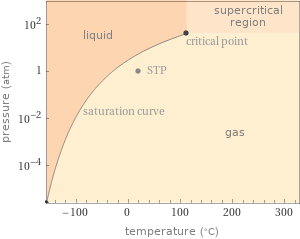Input interpretation

dichlorodifluoromethane | freezing point
Result

-158 °C (degrees Celsius)
Phase diagram

Phase diagram
Units

Unit conversions

115 K (kelvins)

-252 °F (degrees Fahrenheit)

207 °R (degrees Rankine)

-126 °Ré (degrees Réaumur)

-75.4 °Rø (degrees Rømer)
Comparisons as temperature

23 °C below Hg-Tl-Ba-Ca-Cu-oxide superconducting temperature (138 K)

10 °C below Tl-Ba-Cu-oxide superconducting temperature (125 K)

25 °C above boiling point of oxygen (-182.9 °C)
Corresponding quantities

Thermodynamic energy E from E = kT: | 9.9 meV (millielectronvolts)

Blackbody energy flux Φ from Φ = σT^4: | 10 W/m^2 (watts per square meter)

Approximate luminous exitance from a planar blackbody radiator perpendicular to its surface: | 2.1×10^-65 lx (lux)